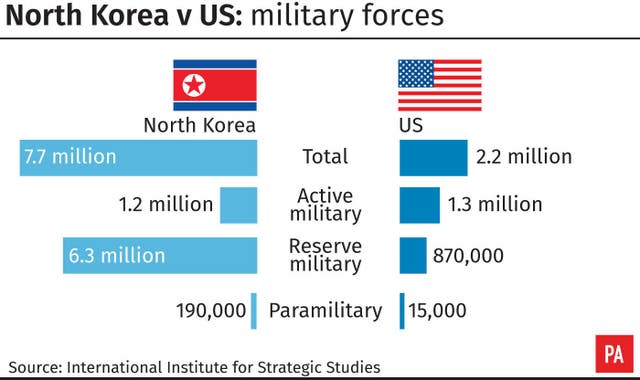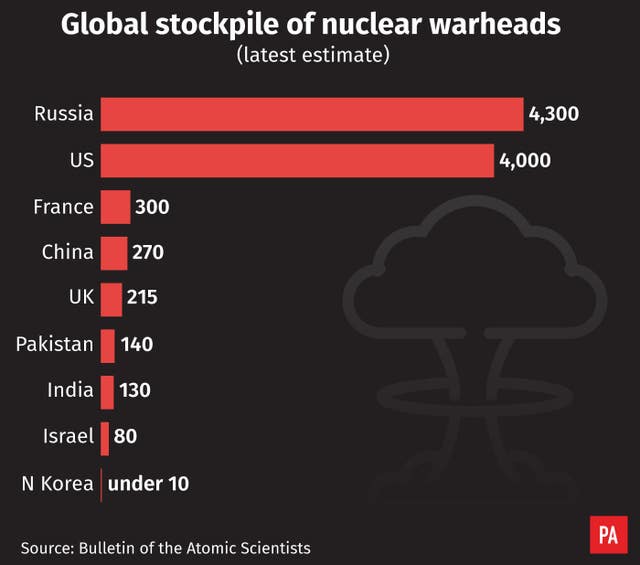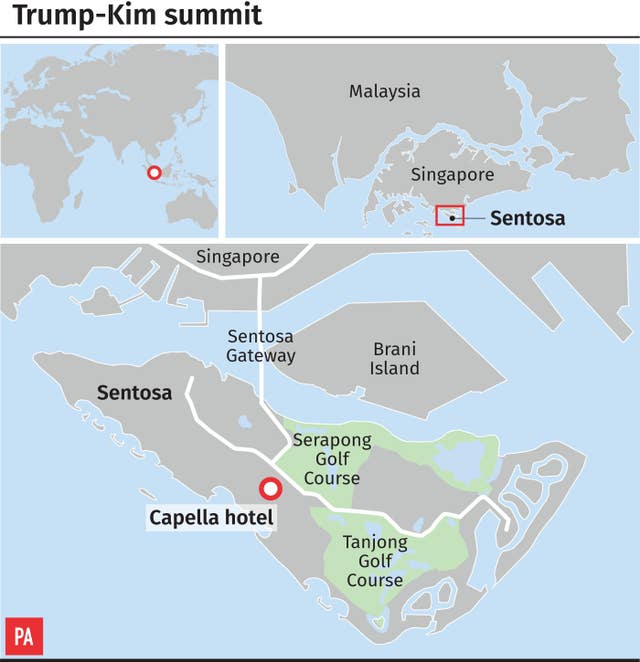Trump optimistic as he and Kim prepare for high-stakes summit in Singapore
The summit will be the first of its kind between a leader of North Korea and a sitting US president.

US President Donald Trump said he thought “things can work out very nicely” with North Korea on the eve of his historic summit with Kim Jong Un.
Mr Trump expressed optimism about Tuesday’s meeting during a working lunch on Monday with Singapore’s Prime Minister Lee Hsien Loong and aides to both leaders.
Mr Trump said “we’ve got a very interesting meeting in particular tomorrow, and I think things can work out very nicely”.
He also told Mr Lee the decision to hold the summit in the island city-state of Singapore was “made very consciously” and offered his thanks.
He said “we appreciate your hospitality and professionalism and your friendship”.

Hours earlier, a jet carrying North Korean President Mr Kim had landed.
After shaking hands with Singapore’s foreign minister, Mr Kim sped through the streets in a limousine, two large North Korean flags fluttering on the car, surrounded by other black vehicles with tinted windows and bound for the luxurious and closely guarded St Regis Hotel.

A US official said on Monday that Mr Trump and Mr Kim would first meet one on one with translators in a session that could last up to two hours before they open the meeting to their respective advisers.
Mr Kim smiled broadly as he met Mr Lee.
“The entire world is watching the historic summit between (North Korea) and the United States of America, and thanks to your sincere efforts… we were able to complete the preparations for the historic summit,” Mr Kim told Mr Lee through an interpreter.
Mr Trump has said he hopes to make a legacy-defining deal for the North to give up its nuclear weapons, though he has recently sought to minimise expectations, saying more than one meeting may be necessary.
The North has faced crippling diplomatic and economic sanctions as it has advanced development of its nuclear and ballistic missile programmes.

White House press secretary Sarah Huckabee Sanders said Sung Kim, the US ambassador to the Philippines who has taken the lead on policy negotiations with the North, will hold a “working group” with a North Korean delegation.
The North Korean autocrat’s every move will be followed by 3,000 journalists who have converged on Singapore, and by gawkers around the world, up until he shakes hands with Mr Trump on Tuesday.

But it was only Monday morning in North Korea that the government news agency reported that Mr Kim was in Singapore, had met Prime Minister Lee Hsien Loong and would meet Mr Trump on Tuesday.
One dispatch by the Korean Central News Agency said North Korea and the US would exchange “wide-ranging and profound views” on establishing new relations, building a “permanent and durable peace-keeping mechanism,” achieving denuclearisation and “other issues of mutual concern, as required by the changed era”.

He has only publicly left his country three times since taking power after his father’s death in late 2011 — travelling twice to China and once across his shared border with the South to the southern part of the Demilitarised Zone for recent summits with the leaders of China and South Korea, respectively.
But it is Mr Kim’s pursuit of nuclear weapons that gives his meeting with Mr Trump such high stakes.

Mr Trump has also raised the possibility of further summits and an agreement ending the Korean War by replacing the armistice signed in 1953 with a peace treaty. China and South Korea would have to sign off on any legal treaty.
It is unclear what Mr Trump and Mr Kim might decide on Tuesday.
Pyongyang has said it is willing to deal away its entire nuclear arsenal if the United States provides it with reliable security assurances and other benefits. But many say this is highly unlikely, given how hard it has been for Mr Kim to build his programme and given that the weapons are seen as the major guarantee to his holding onto unchecked power.
Any nuclear deal will hinge on North Korea’s willingness to allow unfettered outside inspections of the country’s warheads and nuclear fuel, much of which is likely kept in a vast complex of underground facilities. Past nuclear deals have crumbled over North Korea’s reluctance to open its doors to outsiders.
Another possibility from the summit is a deal to end the Korean War, which North Korea has long demanded, presumably, in part, to get US troops off the Korean Peninsula and, eventually, pave the way for a North Korean-led unified Korea.
The fighting ended on July 27 1953 but the war technically continues because instead of a difficult-to-negotiate peace treaty, military officers for the US-led United Nations, North Korea and China signed an armistice that halted the fighting.
The North may see a treaty — and its presumed safety assurances from Washington — as its best way of preserving the Kim family dynasty. The ensuing recognition as a “normal country” could then allow sanctions relief, and later international aid and investment.
Just meeting Mr Trump will also give Mr Kim a recognition North Korea has long sought, setting him up as global player and the leader of a country worthy of respect.
US secretary of state Mike Pompeo said America is prepared to take actions to provide North Korea with “sufficient certainty” that denuclearisation “is not something that ends badly for them”.
Mr Pompeo said the US is prepared to show North Korea that rather than denuclearisation posing a threat to North Korea, it’s “the opposite”.
He would not say whether Mr Trump would consider withdrawing US troops from the Korean Peninsula.
The US secretary of state warned that if diplomacy fails to move in the right direction, the sanctions “will increase”.





